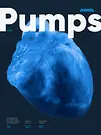The technical heart
The human heart works according to the displacement principle, while the classical pump is a hydraulic machine. Nevertheless, the technical and biological pumps are similar in many ways. The essential part of the technical design of a pump is the rotating shaft line driven by a motor with the impeller because this is the only way to generate the function of pumping in the first place. Despite its importance, the pump on its own cannot move anything. It depends on - biologically speaking - the veins. In the case of the technical pump, this is the cable routing. The substances to be transported ranging from water to pulp, the vital blood, are supplied to the pump and distributed. Here, the butterfly valves play an essential role. Like their biological counterpart - the heart valves - they prevent the return of the water or other substances from the pressure line so that the pump does not work the wrong way around. When the pump operates they are open, otherwise closed. This closing operation is to be done carefully. A rapid closing of the valves should be avoided as the resulting pressure shock can lead to server damages in the plant - a „heart attack“ if you like. In contrast to the human heart, this defect can be fixed by a corresponding service on the pump. In order to keep your biological pump in good condition, a healthy and balanced diet, regular exercise and much else is generally recommended. The same applies to the technical sibling. Excellently designed pumps use the supplied energy, the nutrients, as well as available resources in the best possible way to achieve their stipulated efficiencies. For this, the tissue - that is, the material - must fit. Depending on which substances and how they are transported, certain factors in the choice of materials need to be met. Likewise, the use rather the operation of the pump plays a role. The more continuous the operation the longer the pump lives. A strongly alternating operation such as frequent switching off and on is comparable to a switching back and forth between rest pulse and peak performance and is in the long term not beneficial to the life of both pumps.







